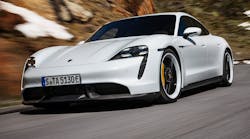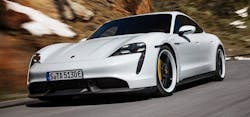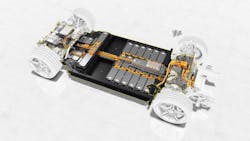On the day of the global launch of the Porsche Taycan, the 750-horsepower electric vehicle (EV) was brought from 5% to 88% charge in just 22.5 minutes at Volkswagen's Electrify America charging station in Bloomsburg, Pa. (Fig. 1). The vehicle charged at a maximum power level of 270 kW—the fastest charging speed for passenger vehicles on the road today.
1. Porsche’s first fully electric sports car has a 280-mile range and sprints to 60 mph in 2.8 seconds.
By way of comparison, Tesla officially says its Model S can charge up to 130 miles in 15 minutes, around 35% of its total range of 370 miles.
The Taycan is the first production vehicle with a system voltage of 800 V instead of the usual 400 V for electric cars (Fig. 2). According to Porsche, in just over five minutes the battery can be recharged using direct current (dc) from a high-power charging network for a range of up to 100 km (according to the European WLTP cycle standard). The charging time for 5% to 80% SoC (state of charge) is 22.5 minutes for charging under ideal conditions, and the maximum charging power (peak) is 270 kW. The overall capacity of the battery system is 93.4 kWh.
As part of Volkswagen’s 2016 diesel emissions settlement, regulators forced the automaker to invest $2 billion over 10 years in charging infrastructure. VW established Electrify America, with a mission to increase EV adoption by building hundreds of charging stations. Each highway site will have between 4 and 10 chargers, two of them offering 350 kW of power and the others at 150 kW. All of the chargers will support CCS Combo charging, and one of the 150-kW chargers will be a dual station that also supports the CHAdeM charging format developed by Japan’s automakers.
Initially, Porsche is offering two Taycan models: “Turbo” offers 630 lb-ft. of torque and 616 hp (with up to 671 hp worth of overboost power). “Turbo S” provides 774 lb-ft. of torque and 616 hp (with up to 750 hp of overboost power). Both are all-wheel drive vehicles with a 93.4-kWh battery pack and two electric motors. There’s a single-speed permanent synchronous electric motor on the front axle and a permanent synchronous electric motor on the rear axle along with a unique two-speed transmission—first gear for faster acceleration from a standing start and a longer-ratio second gear for efficiency at top speeds.
2. The Taycan is the first production vehicle with a system voltage of 800 V.
Earlier this year, auto supplier ZF showed a 140-kW two-speed drive unit for electric cars (scalable up to 250 kW) that consists of an electric motor, two-speed transmission, and power electronics integrated into a compact drive.
The two-speed concept benefits performance. Until now, with electric motors, vehicle manufacturers have had to choose between high initial torque and a high top speed, which with a single-speed transmission would require installing a larger motor. Vehicles with a two-speed drive are also said to consume less energy, which in turn extends range when compared to a single-speed unit.
Porsche says the Turbo S can hit 60 mph in 2.8 seconds and has a 256-mile range; the Turbo can accelerate to 60 mph in 3.2 seconds with a 280-mile range. Both models top out at 161 mph.
The Taycan’s battery pack consists of 33 cell modules, each of which contains 12 individual 64.6 amp-hour cells. They’re arranged such that half of the cells are in parallel with the other half.
There are two charging ports on the car, one on the driver’s side to accommodate a type 1 ac plug, and a CCS type 1 style plug on the passenger’s side.
When using a typical 400-V dc charger, the Taycan’s 50-kW dc onboard charger can get the vehicle’s battery from 5% to 80% charged in 93 minutes. An optional 150-kW onboard charger increases charging speeds, enabling a 5%-to-80% charge in 36 minutes. There’s also an ac onboard charger that converts ac to dc for at-home charging. Taycan drivers can charge their cars with up to 11 kW of alternating current (ac) at home, which will require about six hours of charging.
Elsewhere, the Hyundai Group, including its Hyundai brand and Kia, announced that it will equip its electric cars with an 800-V charging system in 2021 to achieve 350-kW charging from partner IONITY. IONITY is a European venture to create a high-power-charging network across the continent, which counts Daimler, Ford, VW, and BMW among its members. The group is using an 800-V system and plans to have high-power chargers capable of a maximum of 350 kW.



